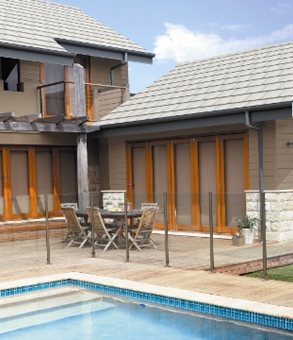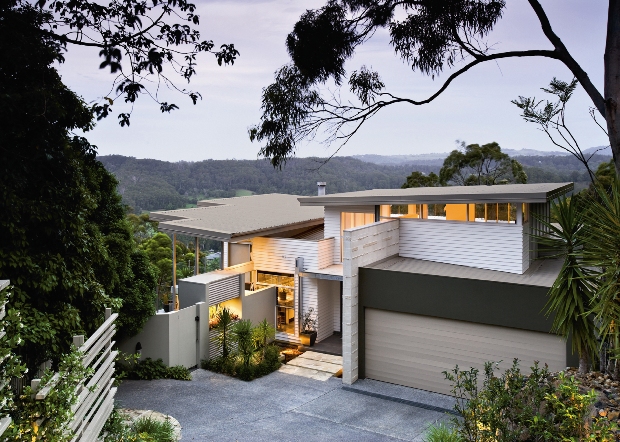Danielle Bowling takes a bird’s eye view of building trends and considers the colourful array of roofing material options now available.
The roof is the second largest element of the external façade of a house, so it goes without saying that its design and colour selection should be a major consideration in new builds or renovations. After all, the roof contributes up to 30 percent of the overall look of a house’s façade.
According to Lisa Tadrosse, product manager, roofing, at CSR Bricks and Roofing, trends in the colour of Aussie roofs today are very much dependent on location.
“Northern states such as Queensland tend to prefer lighter colours whilst down south in Victoria traditional shades such as reds are popular. However, in general, greys are popular across the board,” she says.

“When it comes to roof colour selection, Australian’s are largely conservative, opting for the ever popular blacks, greys and neutral tones. However, in recent times, there has been a return to colours such as straw, slate and earthy terracotta.”
Tadrosse adds that in suburbs with Art Deco and Federation homes, traditional red or dry press bricks and earthy terracotta roofs are popular, while in coastal regions, lighter construction materials reign supreme. Looking forward, CSR predicts two big trends in roofing materials: solar tile, an integration of solar technology in a roof tile; and flat concrete tiles, which they say are extremely popular at the moment.
“The flat profile gives more design flexibility and delivers a streamlined look which is current with modern architectural trends. Grey/black colours are extremely popular as they scheme well with other façade materials,” she says.
Apart from location, roofing colour choice should also be influenced by the house’s immediate surrounds and other building materials, says Boral’s design consultant, Judy Dymond. “Roofing colours are developed in consideration with a number of factors: colourations of the other materials used to construct the building, that is: bricks, fascia and guttering, render, paint, window and garage finishes.
“Landscaping and planting species also influence the feel of the site and location. Generally there is a natural, more greyed influence in the colour palette with greys and charcoals preferred. However there is also a growing interest in lighter colours which are neutral in appearance,” Dymond explains.
She too is noticing that where reds were previously more popular, being influenced by brick, there is now more of an interest in greys and natural tones. However black is also a common choice, and this will lead to a more varied range of dark tone options for home owners.

In terms of materials, both terracotta and concrete are popular and both have a range of design options available.
“Terracotta is a timeless premium material ... there are stylish tones in neutral medium to dark colourations such as Boral’s Eclipse, Wild Choc, Ghost Gum Grey and Antique Bronze. These are available in both a contemporary, flat shingle profile and a classic French profile.
“A wide range of [concrete] colours from dark Ebony to light Barley Stone are available from Boral. There is also a colour through option with particular profiles where the applied colour is inherent to the substrate with the colour being consistent from the base to the topface. This is usually in a Charcoal Grey,” says Dymond.
Add to the list housing style. Like Tadrosse, Brett Ward, general manager, marketing from Austral says housing styles can help to determine appropriate roofing colours.
He agrees that northern states like Queensland are leaning towards lighter colours like creams and offwhites, whereas in Victoria, the ACT and other southern states, blacks and greys are more common.
“A consistent trend in recent years across all markets has been the use of mid tone brown colours, which home owners across the country seem to have embraced due to its ability to complement other façade materials such as timber, sandy coloured brick and stone feature walls,” he says.
“Oranges, reds and greens are often used to complement traditional style homes while off-whites, light browns and cream colours are more popular with contemporary looking home designs. Colours such as black and grey tend to suit a range of styles from contemporary to traditional, and in terms of materials, a Colorbond roof is still commonly identified with the old heritage look or Queenslander style.”
Looking to the future, Ward expects the popularity of flat, minimalist roofing materials to continue, as they provide a very contemporary look and are also extremely versatile.
“Unlike other roofing materials, roof tiles are available in both single and multiple colours, which allows consumers to create very specific looks for their projects that help differentiate them from other properties.
“At present, roof tiles are manufactured in over 50 colours and at least 15 different profiles, meaning consumers are really spoiled for choice,” he says. Ward adds that advancements are also being made in the sustainability of roofing materials, with research into recycled materials tipped to help reduce the environmental impact and embodied energy of roof tiles as well.

Lighter colours, other than being aesthetically pleasing, have the added benefit of contributing to the thermal efficiency of a house.
Colorbond Steel’s Thermatech technology, which reflects more of the sun’s heat and helps reduce a building’s energy load, helps to keep occupants comfortable and reduces their reliance on air-conditioning.
“Lighter colours are becoming more popular, particularly in warmer climates, due to their thermal efficiency properties and ability to meet BASIX (the Building Sustainability Index) and BCA (Building Council of Australia) requirements. Seven colours in the Colorbond steel palette are now classified as light or very light under BASIX and the BCA’s colour classification, however even darker
colours now perform better,” explains Lisa Dent, marketing manager, residential, at BlueScope Steel.
“This offers homeowners a greater choice of colours and in some parts of Australia, reduces the amount of insulation required to meet building regulations.”
BlueScope advises that homes in rural areas, surrounded by bush or green landscapes should go for muted toned roofs, like Colorbond’s Bushland, Wilderness, Pale Eucalypt or Jasper, whereas coastal homes with a seaside ambience should go for subdued blues such as Evening Haze, Windspray, Deep Ocean or the sandy coloured Sandbank.
Dent says, “Despite the different locations of housing and surrounding natural environments - for example, rural, coastal and metro - the broad palette in the Colorbond steel range provides colour design flexibility no matter where you live.”

